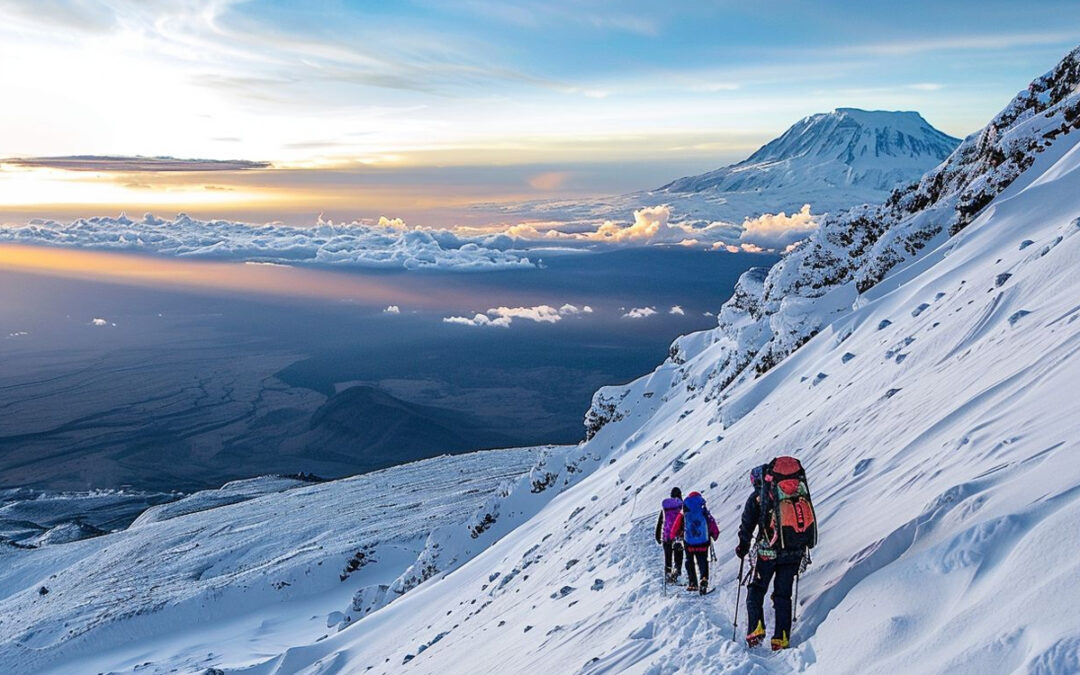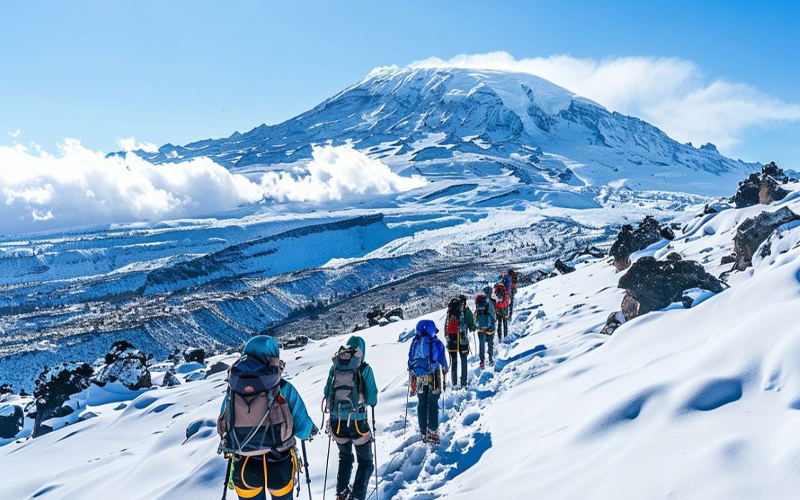Kilimanjaro trekking routes 2025
Mount Kilimanjaro, the “Roof of Africa,” remains one of the most iconic trekking destinations in the world. With its towering height of 5,895 meters (19,341 feet), breathtaking landscapes, and unparalleled trekking experiences, Kilimanjaro continues to attract adventurers from all corners of the globe. As 2025 ushers in new developments, let’s explore the fresh routes, enhanced facilities, and what trekkers can expect this year.
Why Kilimanjaro in 2025?
1. Unmatched Scenery and Diversity: Kilimanjaro’s unique appeal lies in its diversity—lush rainforests, alpine deserts, and glacier-capped peaks all in one trek.
2. Renewed Focus on Sustainable Trekking: 2025 marks a stronger commitment to eco-friendly trekking practices, ensuring the mountain’s beauty is preserved for generations.
3. New Trekking Options: Fresh routes and upgrades in trekking infrastructure have been introduced, making the journey more accessible and enjoyable for all.
The 2025 Kilimanjaro Trekking Routes
1. The Northern Circuit (Orbit Kilimanjaro):
- Why It’s Special: Known as the “hidden gem,” the Northern Circuit offers a quieter and more scenic trek.
- Key Features: Excellent acclimatization, panoramic views, and lesser traffic.
- Duration: 9–10 days.
2. Lemosho Route:
- Why It’s Popular: Ideal for first-time trekkers due to its gradual ascent and stunning scenery.
- Key Features: Views of the Shira Plateau and diverse wildlife.
- Duration: 7–8 days.
3. Machame Route:
- The Classic Option: Also known as the “Whiskey Route,” it offers a mix of challenge and beauty.
- Key Features: Steeper ascents and rewarding vistas.
- Duration: 6–7 days.
4. Marangu Route:
- The Easiest Route: Nicknamed the “Coca-Cola Route,” it’s the only one with hut accommodations.
- Key Features: Less physical demand and a direct path to the summit.
- Duration: 5–6 days.
5. Rongai Route:
- Unique Perspective: Approaches Kilimanjaro from the northern side.
- Key Features: Remote and less crowded with drier terrain.
- Duration: 6–7 days.
New Additions for 2025
1. Community-Based Experiences: Local guides and porters are introducing cultural exchanges, allowing trekkers to learn about Chagga traditions and sample local cuisine.
2. Smart Tracking Technologies: GPS-enabled trekking apps provide real-time updates on weather, altitude, and routes.
3. Enhanced Accommodations: New eco-friendly campsites with solar-powered facilities and improved sleeping arrangements enhance the trekking experience.
Preparing for Your 2025 Kilimanjaro Adventure
1. Fitness and Training:
- Start Early: Build your stamina with cardio exercises and long hikes.
- Acclimatization Is Key: Practice trekking at high altitudes to adapt.
2. Packing Essentials:
- Layered clothing for varying temperatures.
- Sturdy hiking boots, trekking poles, and a reliable backpack.
- A refillable water bottle and a UV water purifier.
3. Choose the Right Guide: Opt for operators certified by the Kilimanjaro Porters Assistance Project (KPAP) to ensure ethical practices.
What to Expect on the Trek
1. Changing Weather Conditions: Be prepared for everything from hot sunshine to freezing nights.
2. Stunning Landscapes: Pass through five distinct climatic zones, each with its unique flora and fauna.
3. A Sense of Accomplishment: Reaching Uhuru Peak is an unforgettable achievement that will leave you in awe of your capabilities.
Sustainability on Kilimanjaro
1. Leave No Trace Policies: Trekkers are encouraged to minimize their environmental footprint by avoiding single-use plastics and packing out all trash.
2. Support Local Communities: Choose operators that invest in local development, ensuring fair wages and community support.
3. Eco-Certified Operators: Many operators are now adhering to green standards, using renewable energy and sustainable practices.
Top Tips for First-Time Trekkers
- Take It Slow: The Swahili phrase “Pole Pole” (slowly, slowly) is the mantra for success.
- Stay Hydrated: Drink at least 3 liters of water daily to combat altitude sickness.
- Listen to Your Guide: Their experience is invaluable for both safety and summit success.
Kilimanjaro trekking in 2025 promises an incredible blend of adventure, natural beauty, and cultural immersion. With new routes, enhanced facilities, and a focus on sustainability, there’s never been a better time to take on Africa’s tallest mountain. Whether you’re an experienced hiker or a first-timer, Kilimanjaro offers an unforgettable journey that will leave you with stories to share for a lifetime.
FAQs
- Which is the best route for beginners in 2025?
The Lemosho and Marangu routes are ideal for beginners due to their gradual ascent and shorter durations. - When is the best time to climb Kilimanjaro in 2025?
The dry seasons, from January to March and June to October, offer the best weather conditions. - How much does it cost to trek Kilimanjaro?
Costs range from $1,500 to $4,000, depending on the route and operator. - Do I need prior trekking experience?
No, but physical fitness and preparation are crucial for a successful trek. - Is Kilimanjaro suitable for solo travelers?
Yes, many operators organize group climbs where solo travelers can join.



